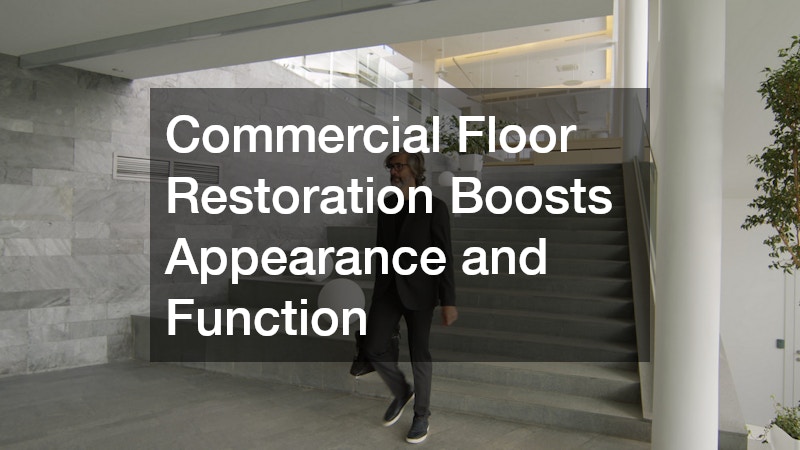Explore the importance and impact of commercial floor restoration on workplace aesthetics and employee morale. Well-maintained floors not only elevate the visual appeal but also foster a positive environment conducive to increased productivity.
What Are the Benefits of Commercial Floor Restoration?
Improved Aesthetic Appeal
Enhancing the visual appearance and first impressions of office spaces through floor restoration is crucial for businesses wanting to project professionalism. A beautifully restored floor reflects the company’s commitment to excellence and attention to detail.
Visitors and clients are often swayed by first impressions, and immaculate floors can play a pivotal role in their perception. Employees, too, take pride in their workplace environment, which can boost morale and job satisfaction.
Moreover, the upkeep of the workplace speaks volumes about organizational values and attitudes towards both employees and clients. Restored floors are an essential investment in the broader corporate image and culture.
Increased Property Value
Exploring how maintaining your floors can contribute to the overall value of the commercial property is essential for savvy business operations. Properties with well-maintained infrastructure, including flooring, tend to have higher property valuations and market appeal.
Investing in floor restoration can be seen as a strategic move that pays off during property assessments or resale. The enhanced aesthetics and functional longevity of floors are features that potential buyers and renters value highly.
An attractive, seamless floor surface can differentiate a property in a competitive real estate market. Therefore, regular floor maintenance plays a significant role in retaining and potentially boosting commercial property value over time.
How Does Commercial Floor Restoration Enhance Workplace Safety?
Reducing Slip and Fall Risks
Examining how restored floors minimize workplace accidents through improved traction and even surfaces is crucial to workplace safety. Slip and fall incidents are common in many businesses, but can be drastically reduced by ensuring that floors are in top condition.
Regular floor restoration involves addressing surface inconsistencies that could lead to potential hazards. By smoothing surfaces and employing non-slip finishes, companies can create safer environments for both employees and visitors.
Restored floors offer enhanced grip and stability, mitigating risks that could lead to costly legal and medical ramifications. Comprehensive floor restoration plans include measures to monitor and improve upon these critical safety aspects.
Compliance with Safety Standards
The role of floor restoration in adhering to the regulations and standards set by safety agencies should not be underestimated. Maintaining floors in accordance with safety guidelines prevents costly non-compliance penalties.
Businesses that prioritize compliance are often viewed more favorably, both internally by employees and externally by partners or clients. Adhering to prescribed safety measures underscores a company’s commitment to the welfare and safety of its stakeholders.
Regular engagement with professional floor restoration services ensures that any potential safety violations are addressed swiftly. It sends a message of responsibility, potentially minimizing risks and avoiding detrimental setbacks.
What Are the Different Types of Commercial Floor Restoration Techniques?
Floor Polishing and Buffing
A look into polishing and buffing techniques that give floors a shiny, smooth finish demonstrates the process’s focus on aesthetics and texture. These techniques are essential in removing surface imperfections and rejuvenating dull surfaces.
The buffing process involves the use of specialized equipment and materials, providing uniformity and a high-gloss finish that is visually appealing. Such enhancements can significantly uplift the overall ambiance of the workplace.
Moreover, polishing and buffing prolong the lifespan of floors, ensuring that they remain attractive and functional over the years. These restoration techniques contribute significantly to maintaining a comfortable, appealing working environment.
Sealing and Coating Solutions
Understanding the protective measures that sealing and coating provide for extended floor life is key to longevity. These solutions create barriers against wear and tear, protecting the floor surface from damage.
Sealing helps in preventing stains and liquid penetration, particularly important in areas with heavy foot traffic. Coating, on the other hand, adds an extra layer of resilience, shielding against abrasions and scratches.
Both sealing and coating involve the application of advanced materials that enhance durability and simplify cleaning and maintenance. Besides offering protection, these solutions contribute to the floor’s visual appeal and structural integrity.
How Often Should Commercial Floor Restoration Be Performed?
Factors Influencing Restoration Frequency
Discussing different elements such as traffic, floor material, and maintenance affecting restoration timelines emphasizes the need for a tailored approach. High-traffic areas, for example, may require more frequent restoration efforts compared to less-used spaces.
The material of the flooring also determines restoration needs; certain materials may wear out quicker under similar conditions. Therefore, understanding these factors is imperative in establishing an effective restoration schedule.
In addition to these physical considerations, budgeting and operational downtimes are essential factors. Balancing these elements can lead to the formulation of an optimal maintenance calendar, ensuring resources are used efficiently.
Creating a Maintenance Schedule
Guidelines for establishing effective restoration schedules to maintain optimal floor condition are essential for long-term benefits. A well-maintained schedule prevents minor issues from escalating into costly repairs or replacements.
Regular assessment of floor conditions, coupled with professional advice, can inform timely interventions and restorations. This proactive strategy minimizes disruptions while ensuring that the flooring remains in pristine condition.
Planning for regular floor maintenance can significantly impact operations by avoiding major renovations and maintaining consistent workplace aesthetics. Consequently, such schedules should be adaptable, accommodating any unforeseen needs or changes.
Summarizing the key benefits and best practices in commercial floor restoration, it is clear that both aesthetic and functional advantages abound. As we have discussed, investing in regular restoration aligns with best practices for enhancing workplace appearance and functionality.
For any commercial space, maintaining floors in excellent condition is crucial, making restoration an essential practice. By understanding its benefits and nuances, businesses can ensure that their flooring continues to reflect their standards of excellence.

